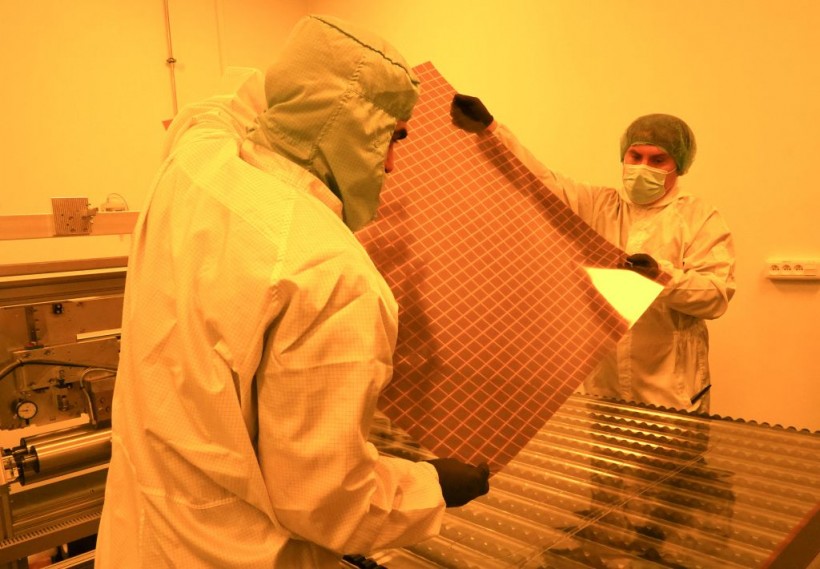Scientists achieved something that could change the renewable energy market in the future. A "miracle material," called perovskite, has been tested to improve the sunlight-to-energy efficiency of solar panels.
Perovskite is not exactly new. Scientists have already known its potential to be used in solar panels. However, that potential has never been tested conclusively yet.
Two separate studies by teams of researchers from China and Japan published on Thursday have conclusively proven that perovskite can achieve the efficiency of photovoltaic (PV) solar cells to over 30%, above the known limit of 29 for traditional PV solar cells made with silicon.
The test results have concluded that it is possible to push the threshold of PV cells and produce low-cost solar panels for consumers. With the discovery of a new solar cell that relies on night-vision technology to generate and store electricity even in complete darkness, it seems that solar energy is on the rise.

Two employees of Polish firm Saule Technologies handle a solar panel on May 20, 2021 in the southern city of Wroclaw, Poland, as the company launches on May 21, 2021 the world's first industrial production line of solar panels based on groundbreaking perovskite technology. - Photovoltaic panels coated with perovskite film are light, flexible and can easily be fixed to almost any surface to produce electricity even inside buildings.
What Is Perovskite?
Perovskite is a mineral discovered in the Ural Mountains of Russia in 1839 by Gustav Rose, and it was named after Russian mineralogist Lev Perovski.
It has calcium, oxygen, and titanium, with a chemical formula of CaTiO3. The perovskite and perovskite structure are often used interchangeably.
A perovskite structure is a compound that has the form ABX3 and the same crystal structure as perovskite. The easiest way to describe a perovskite structure is a cubic unit cell with a calcium atom in the middle, oxygen atoms near the edges, and titanium atoms at the corners.
Perovskite materials show many other interesting and intriguing properties, such as ferroelectricity, charge ordering, and high thermopower, among others. Some Perovskites are also superconductors that can conduct electricity with no resistance at all.
Perovskite can potentially be used in sensors and catalyst electrodes, certain types of solar cells, fuel cells, lasers, memory devices, and spintronics applications.
Also Read: Floating Solar Panels in the North Sea Announced
Silicon Shortage
Although the "silicon crisis" appears to be over, many experts say it's still not. The chip shortage has yet to be completely rectified but has seen significant improvements this year.
Demand for silicon in the production of semiconductors has been severely affected by the COVID pandemic. Most of its uses are in wireless technology and computing, which amounts to $286 billion combined.
In the meantime, because of the shortage and supply-chain issues, the production of silicon solar panels has been put on the back burner in favor of the industry that has four times the demand.
Miraculous Efficiency
Zeev Valy Vardeny, a materials science professor from the University of Utah, described perovskite in 2017 as "a miracle material" after it boosted the sunlight-to-energy efficiency of solar cells. Perovskite harvests energy better from sunlight. However, it was previously deemed too unstable to be used outside of a laboratory.
When scientists behind the latest research put a layer of perovskite on top of silicon into a tandem device, they were able to improve the efficiency of commercial PV technologies while maintaining industry standards.
They think these "tandem solar cells" could help make the cost of solar energy cheaper and continue humanity's efforts in converting to renewable energy. The scientists believe their approach could ultimately achieve an efficiency rate "well above" 35%.
The current efficiency record set for this next-generation solar cell is 33.7%, done by KAUST Solar Center engineers in Saudi Arabia earlier this year. It's important to note that back in 2009, the max efficiency rate was just 4%.
Chinese and Japanese scientists behind this latest breakthrough are planning to create new, more efficient, and cheaper solar panels.
According to Professor Tan Hairen from Nanjing University, a startup in China has already announced that it planned to start production of tandem solar cells, with the ample of perovskite cutting costs to only "one 20th of traditional solar cells."
Related Article: 'Solar Facade': These Embedded Solar Panels Produce 50 Times More Power Than Standard Panels!










